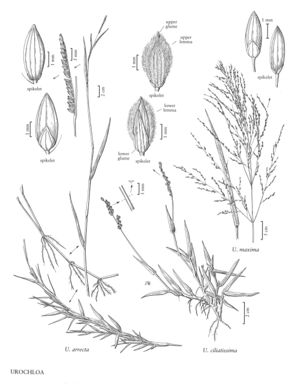Difference between revisions of "Urochloa ciliatissima"
FNA>Volume Importer |
FNA>Volume Importer |
||
| Line 23: | Line 23: | ||
-->{{Treatment/Body | -->{{Treatment/Body | ||
|distribution=Ark.;Okla.;N.Mex.;Tex. | |distribution=Ark.;Okla.;N.Mex.;Tex. | ||
| − | |discussion=<p | + | |discussion=<p>Urochloa ciliatissima is endemic to Texas, Oklahoma, and Arkansas, and grows on sandy soils. Reports of its occurrence in Mexico are based on misidentifications (Morrone and Zuloaga 1993).</p> |
|tables= | |tables= | ||
|references= | |references= | ||
| Line 39: | Line 39: | ||
|basionyms= | |basionyms= | ||
|family=Poaceae | |family=Poaceae | ||
| + | |illustrator=Linda A. Vorobik and Cindy Roché | ||
|distribution=Ark.;Okla.;N.Mex.;Tex. | |distribution=Ark.;Okla.;N.Mex.;Tex. | ||
|reference=None | |reference=None | ||
| Line 44: | Line 45: | ||
|publication year= | |publication year= | ||
|special status= | |special status= | ||
| − | |source xml=https:// | + | |source xml=https://bibilujan@bitbucket.org/aafc-mbb/fna-data-curation.git/src/314eb390f968962f596ae85f506b4b3db8683b1b/coarse_grained_fna_xml/V25/V25_1332.xml |
|subfamily=Poaceae subfam. Panicoideae | |subfamily=Poaceae subfam. Panicoideae | ||
|tribe=Poaceae tribe Paniceae | |tribe=Poaceae tribe Paniceae | ||
Revision as of 17:15, 30 October 2019
Plants perennial; shortly rhizomatous or with long stolons. Culms 10-40 cm, erect to ascending, solitary or in small clumps; nodes retrorsely villous; internodes glabrous. Sheaths glabrous or with papillose-based hairs; ligules 0.5-1.5 mm; blades 1-7(9) cm long, 2-5 mm wide, glabrous or pilose on both surfaces, margins ciliate basally, with papillose-based hairs. Panicles 3-6 cm long, 0.5-1 cm wide, with 2-6 spikelike primary branches in 2 ranks; rachises scabridulous; primary branches 0.5-2 cm, appressed, axes 0.3-0.4 mm wide, triquetrous, scabridulous, glabrous or puberulent; secondary branches rarely present; pedicels shorter than the spikelets, scabridulous. Spikelets 3-4.5 mm long, 1.5-2 mm wide, plano-convex, solitary, in 2 rows, appressed to the branch axes. Glumes scarcely separate, rachilla between the glumes not pronounced; lower glumes 2.8-3.2 mm, 5-7-veined, glabrous or with long hairs basally; upper glumes 3-4.5 mm, (9)11-13-veined, with¬out cross venation, mostly puberulent, margins pilose-fringed; lower florets staminate; lower lemmas 3-4.5 mm, 7-9-veined, without cross venation, mostly puberulent, margins pilose-fringed; lower paleas present; upper lemmas 2.4-2.8 mm long, 1.3-1.4 mm wide, planoconvex, apices broadly acute to rounded, mucronate; anthers about 1 mm. Caryopses 1.8-3 mm. 2n = 36.
Distribution
Ark., Okla., N.Mex., Tex.
Discussion
Urochloa ciliatissima is endemic to Texas, Oklahoma, and Arkansas, and grows on sandy soils. Reports of its occurrence in Mexico are based on misidentifications (Morrone and Zuloaga 1993).
Selected References
None.
